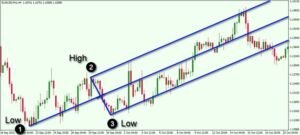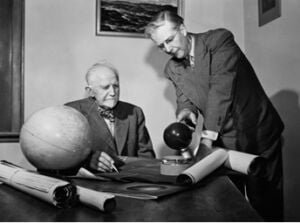By Dr. Raymond A. Keller, a.k.a. “Cosmic Ray,” author of the international awards-winning Venus Rising series of book All of Raymonds Venus Rising Books Can Be Found HERE
Financial guru Roger W. Babson declared a one-man war on gravity following the drowning of his older sister, who was pulled down to the bottom of a river on the outskirts of Gloucester, Massachusetts, during his youth.
“Wizard of Wall Street”
Roger W. Babson (1875-1967) was a self-made man who amassed a great fortune on Wall Street by applying the laws of gravity toward making accurate stock market predictions. He was such an outstanding technical investor that many in the circles of high finance came to call him the “Wizard of Wall Street.” At the start of 1949, he dedicated a goodly portion of his vast financial resources to establish the Gravity Research Foundation (GRF) in New Boston, New Hampshire. The first meeting of the GRF was held on 19 January 1949; and on 1 December of the same year, the first awards for the best essays submitted on the subject of gravity were made.
Babson graduated from the Massachusetts Institute of Technology (MIT) in 1898 with a bachelor of science degree in engineering. It was Babson’s interest in gravity that propelled him to enroll at MIT. This fascination with gravity actually began back in Babson’s childhood, following the drowning of his older sister in a river on the outskirts of Gloucester, Massachusetts. Babson referred to gravity as “our enemy number one” and then elaborated on the origin of his obsession in overcoming this force of nature: “She (his sister) was unable to fight gravity, which came up and seized her like a dragon and brought her to the bottom.”
At MIT, Babson’s favorite class was that taught by the engineering professor George F. Swain. Dr. Swain, to highlight his lectures and keep his students’ attention, used stock market charts to illustrate the application of Isaac Newton’s laws, most notably the law of action and reaction. Babson used the exercises learned in the class to develop his own method of analyzing the stock market and making profitable investments. From Dr. Swain, Babson learned how to draw a nominal line through zigzagging market action on financial charts. After moving on from MIT, Babson established his own investments firm and taught this technical skill to one of his brokers, Alan H. Andrews, who later refined it into “Andrew’s Pitchfork,” a now commonly utilized trendline indicator.
According to the Forex Trading Group, “The Andrews Pitchfork is an on-chart technical indicator that is drawn around recent price action. It falls into the category of channel indicator studies. The structure of the Andrews Pitchfork indicator consists of two parallel lines and a median line in the middle.
In this manner, the Andrews Pitchfork drawing tool has three parallel levels which are equidistant. It is used to gauge the price behavior during an emerging or prevailing trend.” For further information, see https://forextraininggroup.com/rules-for-using-andrews-pitchfork-and-median-lines/.
Interestingly, and unlike countless other investors, Babson and those following this technique, were able to avoid the calamity of the stock market crash of 1929 by selling off early, reaping exceptionally high profits. Just a couple of weeks before the stock market plummeted to record lows, Babson remarked that, “Inasmuch as there was strong upward action, there would now have to follow a severe downward reaction,” adding that, “What comes up will come down, and the stock market will fall by its own weight.”
In the years following World War II, the theory of gravity was largely a neglected area of research in the scientific community and Babson wanted to energize it. To this end, he consulted his close associate, George M. Rideout, then President of Babson Reports, his primary stock analysis firm, as to how best to proceed to encourage the study of gravity. After some consideration, George Rideout advised him to start a foundation and to solicit ideas by offering annual awards for the best ideas submitted. Roger Babson accepted the advice and the GRF was formed. The GRF is still in existence, but still little known to most in the UFO community, to whom it should matter most.
According to the GRF website, “Babson’s main interest was to stimulate interest in the study of gravity. He hoped that ultimately unique and practical applications would be found. His views were reflected by the wording in the announcement of the first essay competition that said the awards were to be given for suggestions for anti-gravity devices, for partial insulators, reflectors, or absorbers of gravity, or for some substance that can be rearranged by gravity to throw off heat. Although not specifically mentioned in the announcement, he was thinking of absorbing or reflecting gravity waves. The wording was unusual and the scientific community responded with a resounding lack of enthusiasm. George Rideout recognized that the wording discouraged the best scientists from submitting essays. He succeeded in convincing Babson that, if one understood completely the theory of gravity, one would understand its possible applications. He was able to modify the statement in the annual announcement of the essay competition so that it has been for many years, and almost from the beginning, stated that the awards are given for essays on the subject of gravitation, its theory, application, or effects.”
Although Babson’s obsession with gravity was considered, by most, nothing more than a “pipe dream” back in 1949, in today’s world the theory of gravity is one of the more active areas of research in theoretical physics. And most ufologists subscribing to the extraterrestrial hypothesis for the origin of UFOs would heartily agree that a thorough and comprehensive theory of gravity is needed to explain the existence of flying saucers as interplanetary spacecraft covering the immense distance between the stars in such presumably short time spans.
The GRF website acknowledges that Babson, if he were still alive, would certainly recognize that he erred in not thinking boldly enough. The site continues:
“Instead of terrestrial applications, he should have thought of cosmological; instead of static fields, he should have thought of dynamic and radiative effects. Anti-gravity he would now know was associated with dark energy, rearranging matter to produce heat he would associate with Hawking radiation from black holes. He would be doubly excited to know that gravitational radiation has been observed and that a new window for cosmological events has been opened. By any measure, he would feel vindicated in his judgment and satisfied that indeed the study of gravity was no longer being neglected, and it is likely that when gravitational radiation is observed, absorption by other galaxies will also be observed.”
In his later years, Roger W. Babson (left) continued to ponder a utopian future where the application of anti-gravity technology would become a reality. Photo from Babson College archives, Babson Park, Massachusetts.
In looking at gravity as a radiation, we now find ourselves right in line with the speculations offered by John R. R. Searl. In the next section, we shall look at the GRF essay winners for 1949 – 1953, and see how their research was coopted for the development of TOP SECRET aircraft in the United States during the mid-1950s, i.e. the beginnings of the so-called “Skunkworks” and the emergence of an anti-gravity aerospace technology that remains largely hidden, even unto this modern age.




